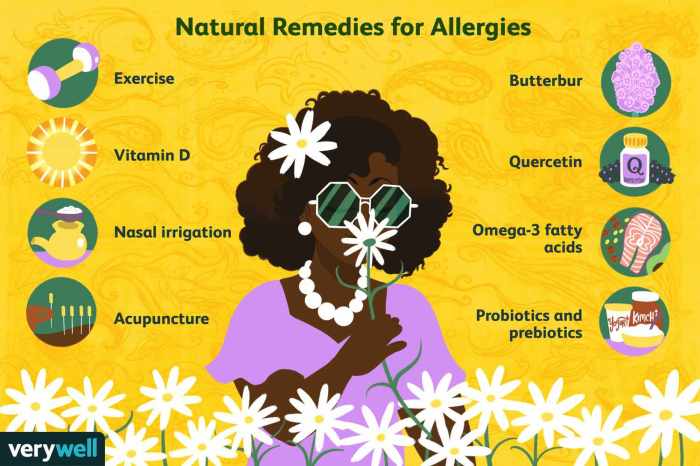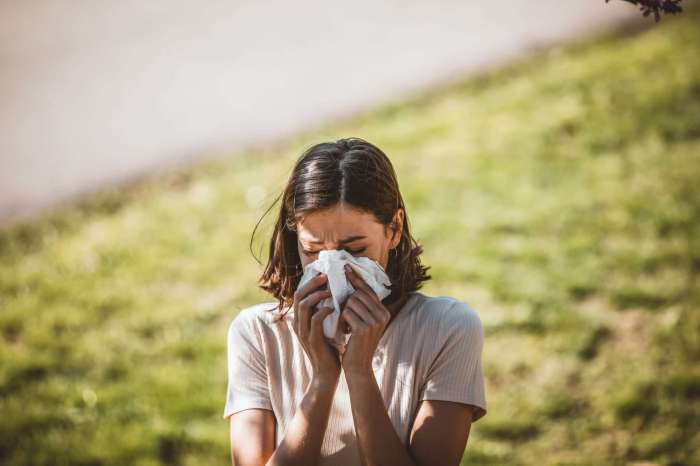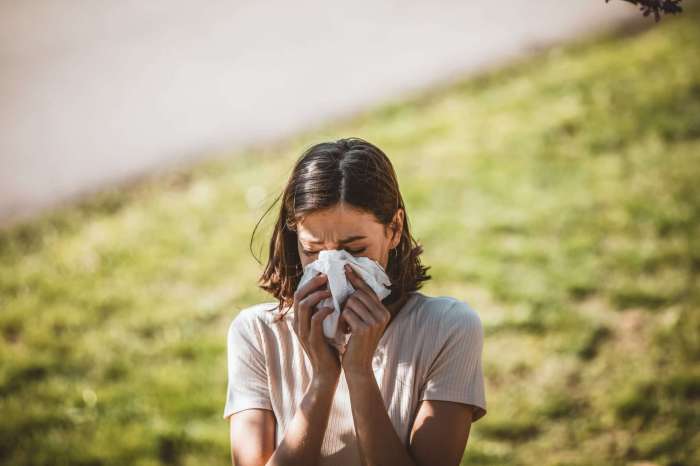How to get rid of seasonal allergies? This comprehensive guide dives deep into understanding these pesky spring and fall ailments. From identifying triggers and prevention strategies to effective medical treatments and natural remedies, we’ll explore various approaches to conquer seasonal allergies and reclaim your comfort.
We’ll cover everything from the science behind allergic reactions to practical lifestyle adjustments. Learn about the different types of allergens, how to minimize exposure, and which treatments work best for you. We’ll also look at allergy-friendly products and techniques for managing symptoms throughout the seasons.
Understanding Seasonal Allergies
Seasonal allergies, also known as hay fever, are a common affliction affecting millions worldwide. They occur when the immune system mistakenly identifies harmless substances, like pollen or mold, as threats, triggering an allergic reaction. This response often manifests in uncomfortable and sometimes debilitating symptoms. Understanding the mechanisms behind these reactions and the specific allergens involved is crucial for effective management and relief.
Allergic Reaction Mechanisms
Seasonal allergies stem from an overreaction of the immune system. Normally, the immune system defends the body against harmful invaders like bacteria and viruses. In allergic individuals, exposure to allergens, such as pollen, triggers the release of immunoglobulin E (IgE) antibodies. These antibodies bind to mast cells, which are found throughout the body, particularly in the respiratory tract and skin.
When the same allergen is encountered again, it binds to the IgE antibodies attached to the mast cells. This binding triggers the release of histamine and other inflammatory mediators. These chemicals cause the characteristic symptoms of seasonal allergies, such as sneezing, runny nose, and itching.
Types of Seasonal Allergens
Allergens are substances that trigger allergic reactions. Seasonal allergies are primarily caused by airborne allergens. Pollen is a major culprit, originating from trees, grasses, and weeds. The specific types of pollen and their peak seasons of release vary geographically. Mold spores, another common allergen, thrive in damp environments and can be released into the air throughout the year.
Dust mites, although not seasonal in the strict sense, can also exacerbate allergy symptoms and are often linked to indoor environments. Pet dander, while not strictly a seasonal allergen, can trigger reactions at any time. In addition to these, certain foods and insect stings can also cause allergic reactions.
Common Allergen Sources
The specific sources of pollen, mold, and other allergens can vary depending on location and time of year. Trees, like birch or oak, are common pollen sources in spring. Grasses like ryegrass and Bermuda grass frequently release pollen during summer months. Weeds, like ragweed, are a significant source of pollen in late summer and fall. Mold thrives in damp areas like basements, attics, or areas with excess moisture.
Dealing with seasonal allergies can be a real drag, but thankfully, there are ways to manage them. Over-the-counter remedies often do the trick, but if you’re pregnant, you need to be extra cautious about what you take. It’s important to consult your doctor before taking any medication, including antibiotics, during pregnancy. For example, understanding the safety of antibiotics while pregnant is crucial.
Check out this resource for more information on can you take antibiotics while pregnant Ultimately, a personalized approach is key to managing seasonal allergies effectively, even during pregnancy.
Molds can also be found in decaying organic matter, such as leaves or compost piles. Identifying the specific allergen is often crucial for developing effective avoidance strategies.
Symptoms of Seasonal Allergies
Seasonal allergies manifest in a range of symptoms, predominantly affecting the respiratory system. These include sneezing, runny or stuffy nose, itchy or watery eyes, and itchy throat or mouth. These symptoms can vary in severity from mild discomfort to significant impairment of daily activities. Important to distinguish seasonal allergies from other conditions, like the common cold or influenza.
These viral infections can also cause respiratory symptoms, but often accompany other symptoms like fever, body aches, and fatigue.
Distinguishing Seasonal Allergies from Other Respiratory Illnesses
| Feature | Seasonal Allergies | Common Cold | Flu ||—|—|—|—|| Symptoms | Sneezing, runny nose, itchy eyes | Sneezing, runny nose, sore throat | Fever, body aches, cough, fatigue, runny nose, sneezing || Duration | Typically seasonal | Typically 7-10 days | Typically 5-7 days || Fever | Absent | Absent (usually) | Present || Body aches | Absent (usually) | Absent (usually) | Present || Fatigue | Mild (usually) | Mild (usually) | Severe |
Prevention Strategies
Seasonal allergies can significantly impact daily life, but proactive prevention strategies can greatly reduce their effects. Understanding your triggers and implementing appropriate measures can significantly lessen the severity and frequency of allergic reactions. This section will Artikel various methods to minimize exposure and manage symptoms effectively.Effective allergy prevention involves a multifaceted approach, combining avoidance strategies, lifestyle adjustments, and potentially, medical interventions.
By identifying and minimizing exposure to allergens, individuals can significantly improve their quality of life during allergy season.
Minimizing Outdoor Exposure
Understanding your allergy triggers is crucial for minimizing outdoor exposure. Common triggers include pollen from trees, grasses, and weeds, as well as mold spores. Knowing the specific plants that trigger your allergies, and the times of day or weather conditions when pollen counts are highest, can help you plan your outdoor activities accordingly.
- Timing outdoor activities: Scheduling outdoor activities for times of day when pollen counts are typically lower, such as early mornings or evenings, can significantly reduce exposure. For example, if you know ragweed pollen is highest in the afternoon, you might choose to exercise early in the morning.
- Using protective measures: Wearing a mask or scarf can filter out some airborne allergens. Keeping windows closed during high pollen periods can also help reduce indoor allergen levels. Long sleeves and pants can provide additional protection.
- Avoiding high-risk locations: Knowing the areas in your neighborhood with higher concentrations of pollen-producing plants or mold can help you choose alternative routes for walks or bike rides.
Managing Outdoor Activities
Effective management of outdoor activities during allergy season requires careful planning and preparation. This includes adjusting your schedule and utilizing preventive measures.
- Pollen counts: Checking local pollen counts before engaging in outdoor activities can help you anticipate and mitigate potential allergy symptoms. Many websites and apps provide real-time pollen data.
- Timing of activities: Scheduling strenuous activities or outdoor sports for times when pollen counts are lower can minimize symptom severity. For instance, if you know oak pollen is prevalent during the midday sun, you might choose to engage in outdoor activities early in the morning or late in the evening.
- Protective gear: Wearing protective clothing, such as a pollen mask, can significantly reduce the amount of pollen inhaled during outdoor activities. This can be particularly helpful for those with severe allergies.
Indoor Measures to Control Allergens
Controlling indoor allergens is essential for managing seasonal allergies. A proactive approach can create a healthier and more comfortable indoor environment.
- Cleaning regularly: Regularly vacuuming, dusting, and washing bedding can remove dust mites, pet dander, and other indoor allergens. This is crucial for maintaining a clean and allergen-free environment, especially for those with allergies.
- Using air purifiers: Air purifiers with HEPA filters can trap airborne allergens, reducing their presence in the home. They are an effective tool in controlling indoor allergens.
- Controlling humidity: Maintaining proper humidity levels can reduce the growth of mold and mildew, two common indoor allergens. Using a dehumidifier or a humidifier can help.
Preventative Measures: Pros and Cons
Different preventative measures offer varying levels of benefit and have different drawbacks.
| Preventative Measure | Pros | Cons |
|---|---|---|
| Air Purifiers | Reduce indoor allergen levels, improve air quality | Can be expensive, require regular maintenance, may not eliminate all allergens |
| Medications (e.g., antihistamines) | Can alleviate symptoms quickly, available over-the-counter | May have side effects, may not prevent all symptoms |
| Pollen masks | Filter out airborne allergens, provide protection during outdoor activities | Can be uncomfortable to wear for extended periods, may not fully prevent inhalation |
| Regular cleaning | Removes dust mites, pet dander, and other allergens | Requires time and effort, may not completely eliminate allergens |
Identifying and Avoiding Triggers
Identifying and avoiding common triggers in your environment is a key aspect of preventing seasonal allergies.
- Keeping a diary: Recording your symptoms and potential triggers can help you identify patterns and pinpoint the specific allergens affecting you.
- Environmental awareness: Understanding the common allergens in your area, such as pollen counts and mold spores, can help you avoid high-risk situations.
- Avoiding known triggers: Once you identify your triggers, take steps to avoid them as much as possible. This could involve avoiding certain plants, pets, or activities.
Medical Treatments
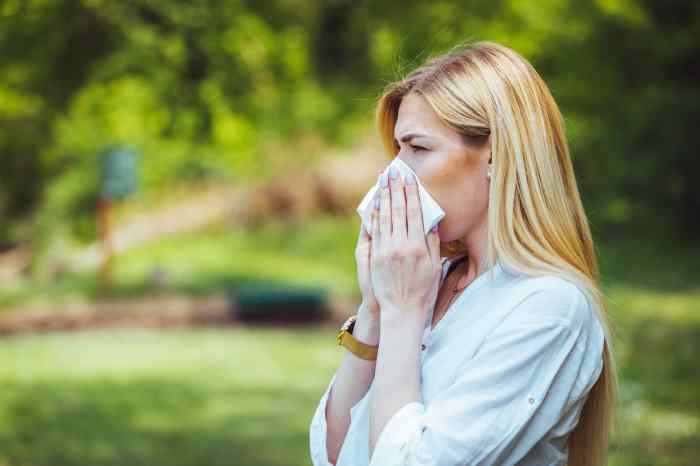
Seasonal allergies can significantly impact quality of life. Fortunately, various medical treatments are available to help manage symptoms and alleviate discomfort. Understanding the different options, their effectiveness, and potential side effects is crucial for making informed decisions about your treatment plan.Effective management of seasonal allergies often involves a combination of lifestyle adjustments, preventative measures, and, when necessary, medical interventions.
This section focuses on the various medical treatments available, ranging from over-the-counter medications to more intensive therapies like immunotherapy.
Allergy Medications
Over-the-counter and prescription medications can effectively reduce allergy symptoms. These medications work by targeting different pathways in the body’s response to allergens. Understanding the various types and their mechanisms of action is essential for selecting the most appropriate treatment.
- Over-the-Counter (OTC) Medications: These medications, such as antihistamines, are commonly used for mild to moderate allergy symptoms. They work by blocking the effects of histamine, a chemical released by the body during an allergic reaction. Examples include loratadine (Claritin), cetirizine (Zyrtec), and fexofenadine (Allegra). While generally safe, OTC medications can still have side effects, such as drowsiness, dry mouth, or dizziness.
Their effectiveness varies depending on the individual and the severity of the allergy.
- Prescription Medications: For more severe or persistent allergy symptoms, prescription medications may be necessary. These medications often work by reducing inflammation and controlling other immune responses. Examples include nasal corticosteroids, such as fluticasone (Flonase) or mometasone (Nasonex), which are often used to reduce nasal congestion and inflammation. Intranasal antihistamines, such as azelastine (Astelin), can also be prescribed.
These medications generally offer stronger symptom relief but may have more significant side effects, which should be discussed with a doctor.
Effectiveness and Side Effects of Medications
The effectiveness of allergy medications varies greatly from person to person. Factors like the severity of the allergy, the specific allergen, and the individual’s overall health can influence how well a medication works. Carefully consider the potential side effects alongside the benefits of each medication.
| Medication Type | Effectiveness | Common Side Effects |
|---|---|---|
| Antihistamines (OTC) | Generally effective for mild to moderate symptoms. | Drowsiness, dry mouth, dizziness. |
| Nasal Corticosteroids (Prescription) | Highly effective in reducing inflammation and congestion. | Nasal irritation, headache, hoarseness. |
| Intranasal Antihistamines (Prescription) | Effective in reducing nasal symptoms. | Nasal dryness, headache, possible interactions with other medications. |
Immunotherapy
Immunotherapy, also known as allergy shots, is a long-term treatment option for seasonal allergies. It involves gradually exposing the patient to increasing doses of allergens to help build tolerance and reduce the body’s allergic response.
“Immunotherapy can significantly reduce allergy symptoms over time, often leading to long-term relief.”
The process typically involves multiple injections over several months or years. It’s crucial to understand that immunotherapy requires a commitment to regular appointments and close monitoring by an allergist. The effectiveness and suitability of immunotherapy depend on various factors, including the type and severity of allergies.
Allergy Testing and Diagnosis
Allergy testing is a crucial step in identifying the specific allergens triggering symptoms. This process helps personalize treatment plans and ensure the most effective approach for managing allergies.
Dealing with seasonal allergies can be a real drag, but there are some helpful strategies. For example, you can try using nasal sprays or over-the-counter antihistamines. Interestingly, while not directly related, similar principles of strengthening and support can apply to other areas of the body. For instance, if you’re looking for ways to manage incontinence, learning how to use vaginal weights for incontinence could be beneficial.
how to use vaginal weights for incontinence This approach focuses on building support and strength, which can also be helpful in addressing the discomfort of seasonal allergies. Ultimately, understanding your body and finding the right solutions is key to managing both types of issues.
- Skin Prick Tests: A common method, skin prick tests involve placing small amounts of suspected allergens on the skin and observing for a reaction. A positive reaction indicates an allergic response.
- Blood Tests: Blood tests, such as IgE antibody tests, measure the presence of specific antibodies related to allergies. These tests can help identify potential allergens and quantify the immune response.
Importance of Professional Consultation
Consulting with a healthcare professional, particularly an allergist, is essential for developing a personalized treatment plan. They can accurately diagnose the specific allergens and recommend the most suitable medication or immunotherapy approach.A healthcare professional can assess individual needs and risks, and tailor a plan to effectively manage allergies and minimize potential side effects. They can also monitor treatment progress and make adjustments as needed.
Natural Remedies for Seasonal Allergies
Natural remedies offer a range of approaches to alleviate seasonal allergy symptoms. While they may not be a complete replacement for medical treatments, many individuals find them helpful in managing their symptoms and reducing reliance on pharmaceutical medications. However, it’s crucial to remember that natural remedies are not always scientifically proven and may have potential side effects or interactions with other medications.
Consult with a healthcare professional before incorporating any new natural remedy into your allergy management plan.Understanding the potential benefits and drawbacks of different natural remedies is essential for making informed decisions. Some remedies may provide temporary relief, while others may offer more sustained support. It’s important to be patient and consistent in using natural remedies, as their effectiveness can vary depending on individual factors.
Effectiveness of Natural Remedies
Natural remedies often work by targeting different aspects of the allergic response, such as reducing inflammation or boosting the immune system. The effectiveness of these remedies varies significantly between individuals. Some people may experience significant relief, while others may find only minor improvements. Factors such as the severity of allergies, individual tolerance, and the specific remedy used all play a role in the outcome.
Types of Natural Remedies
Several natural remedies are purported to help alleviate allergy symptoms. Their mechanisms of action and potential benefits often stem from their anti-inflammatory or immune-modulating properties.
- Herbal Remedies: Many herbs, like chamomile and ginger, are traditionally used for their anti-inflammatory properties. They may help reduce inflammation in the airways and lessen the allergic response. However, some herbs can interact with medications or have side effects, so careful consideration is needed. Consult a healthcare professional before using herbal remedies, especially if you are taking other medications.
- Dietary Supplements: Certain supplements, like vitamin C and quercetin, are thought to help modulate the immune system and reduce allergic reactions. They may also act as antioxidants, potentially reducing the overall inflammatory response. Supplements should be taken in recommended dosages to avoid potential adverse effects. A qualified healthcare provider can offer guidance.
- Acupuncture: Traditional Chinese medicine practices like acupuncture aim to restore balance in the body’s energy flow. Some research suggests acupuncture may help regulate the immune system and reduce allergic reactions, although further investigation is needed to fully understand its effectiveness. The results of acupuncture can vary, and it is important to find a qualified practitioner.
- Homeopathy: Homeopathy uses highly diluted substances to stimulate the body’s healing response. Some proponents believe it can alleviate allergy symptoms, but the scientific evidence supporting its efficacy remains limited. Consult a healthcare professional before using homeopathy, as it may interact with other medications or have unintended effects.
Foods and Beverages for Allergy Relief
Certain foods and beverages are often associated with potential allergy symptom reduction. They may contain compounds that can help to reduce inflammation or support immune function. However, the evidence for these effects is often anecdotal and requires further research.
- Fruits and Vegetables: Many fruits and vegetables, such as berries, citrus fruits, and leafy greens, are rich in antioxidants and vitamins, which can potentially help to support immune function and reduce inflammation.
- Ginger and Turmeric: These spices are known for their anti-inflammatory properties, and incorporating them into your diet may offer relief from allergy symptoms.
- Probiotic-Rich Foods: Foods containing probiotics, like yogurt and kefir, may help support a healthy gut microbiome, which can influence immune function and reduce inflammation.
Natural Remedies Comparison
| Category | Remedy | Potential Effects | Potential Drawbacks |
|---|---|---|---|
| Herbal Remedies | Chamomile | Anti-inflammatory, calming | May interact with medications, allergic reactions possible |
| Herbal Remedies | Ginger | Anti-inflammatory, potential immune support | May cause digestive upset in high doses |
| Dietary Supplements | Vitamin C | Antioxidant, potential immune support | High doses may cause gastrointestinal issues |
| Dietary Supplements | Quercetin | Antioxidant, potential immune modulation | May interact with certain medications |
| Other | Acupuncture | Potential immune regulation | Requires qualified practitioner, individual results vary |
Lifestyle Adjustments
Taking control of your lifestyle can significantly reduce the impact of seasonal allergies. By making thoughtful adjustments in your daily routines, diet, and stress management, you can minimize triggers and alleviate symptoms. These proactive steps can improve your overall well-being and make dealing with allergies much easier.Lifestyle adjustments are crucial in managing seasonal allergies because they directly impact your exposure to allergens and your body’s response to them.
By understanding how certain factors contribute to your allergy symptoms, you can make informed choices to create a healthier, more comfortable environment for yourself.
So, battling those pesky seasonal allergies? One thing that might surprise you is the fascinating composition of boogers, which are essentially dried nasal secretions. Knowing what exactly those sticky little guys are made of could offer a better understanding of how to manage the stuffiness and discomfort that seasonal allergies often bring. Check out this insightful article on what are boogers made of to delve deeper into the science behind those nasal treasures, which can indirectly help you understand how to better treat your allergies.
Ultimately, a combination of nasal sprays, antihistamines, and a healthy lifestyle will likely be the most effective way to win this allergy battle.
Modifying Your Environment
Minimizing exposure to allergens is paramount in managing allergy symptoms. This involves actively identifying and eliminating or reducing exposure to common triggers. Controlling indoor and outdoor environments plays a significant role in preventing allergic reactions.
- Limit Outdoor Exposure During Peak Allergy Season: Consider scheduling outdoor activities for times when pollen counts are lower, such as early mornings or evenings. Pay attention to local pollen forecasts and adjust your plans accordingly. This is especially important for activities like gardening or strenuous exercise, as pollen can be more concentrated during these times.
- Improve Indoor Air Quality: Use air purifiers with HEPA filters to remove airborne allergens like pollen and dust mites. Regularly clean and vacuum your home, paying special attention to areas where dust tends to accumulate. Change your bedding frequently and wash your clothes in hot water to eliminate allergens.
- Seal Windows and Doors: During high-pollen seasons, consider keeping windows closed and using air conditioning whenever possible. This will reduce the amount of pollen entering your home.
Dietary Considerations
The foods you consume can influence your overall health and immune response. A balanced diet rich in nutrients can support your body’s natural defenses against allergies.
- Anti-inflammatory Foods: Incorporating foods rich in antioxidants and anti-inflammatory properties, such as fruits, vegetables, and healthy fats, can help reduce inflammation throughout the body. Examples include berries, leafy greens, and fatty fish like salmon.
- Hydration: Maintaining proper hydration is crucial for overall health and can also help flush out toxins. Drinking plenty of water can support your body’s natural detoxification processes.
- Avoid Allergens: Pay attention to any potential food allergies or sensitivities you might have. Eliminating or minimizing foods that may trigger allergy symptoms can be helpful.
Stress Management Techniques
Stress can weaken the immune system, making you more susceptible to allergy symptoms. Effective stress management is crucial for allergy sufferers.
- Mindfulness and Meditation: Practicing mindfulness and meditation can help manage stress and promote relaxation. These techniques can reduce the body’s stress response and improve overall well-being.
- Regular Exercise: Physical activity releases endorphins, which have mood-boosting effects and can help reduce stress levels. Moderate-intensity exercise, such as brisk walking or jogging, can be highly beneficial.
- Sufficient Sleep: Adequate sleep is crucial for a healthy immune system. A consistent sleep schedule and a relaxing bedtime routine can improve sleep quality and overall well-being.
Improving Sleep and Overall Health
Adequate sleep is vital for maintaining a strong immune system. Good sleep habits can significantly improve your ability to manage allergy symptoms.
- Establish a Consistent Sleep Schedule: Going to bed and waking up around the same time each day, even on weekends, helps regulate your body’s natural sleep-wake cycle.
- Create a Relaxing Bedtime Routine: Engage in calming activities before bed, such as reading or taking a warm bath, to prepare your body for sleep.
- Prioritize Physical Health: Regular exercise, balanced nutrition, and stress reduction techniques contribute to better sleep quality and overall health, strengthening your body’s ability to combat allergies.
Allergy-Friendly Products: How To Get Rid Of Seasonal Allergies
Navigating the world of seasonal allergies can feel like a constant battle against invisible foes. While preventative measures and medical treatments are crucial, strategically incorporating allergy-friendly products into your home and lifestyle can significantly reduce exposure to allergens and improve your comfort level. This approach complements other strategies, offering a layered defense against seasonal discomfort.Choosing the right products can be overwhelming, but with a clear understanding of the available options and their specific features, you can make informed decisions that cater to your individual needs.
This section will detail the various allergy-friendly products available, highlighting their effectiveness and emphasizing the importance of reading labels to ensure you’re making the most of these tools.
Air Purifiers
Air purifiers are powerful allies in the fight against seasonal allergies. They work by trapping airborne allergens like pollen, dust mites, and pet dander, improving indoor air quality. Different models vary significantly in their filtration capabilities and overall effectiveness.
- HEPA filters are a gold standard, capturing microscopic particles. Look for purifiers with a high CADR (Clean Air Delivery Rate) rating, which measures how much clean air the purifier can produce per hour. A higher CADR indicates a more effective filtration system.
- Activated carbon filters can absorb odors and gases, which can be helpful for those sensitive to specific scents. However, their effectiveness in trapping pollen and other allergens is generally lower than HEPA filters.
- UV-C lights can kill certain airborne microbes. While they may not directly target pollen, they can contribute to a cleaner environment. Always ensure UV-C light purifiers have been tested for effectiveness in reducing allergen levels.
Allergy-Friendly Bedding
Protecting your sleep space from allergens is vital for allergy sufferers. Proper bedding plays a significant role in reducing exposure to dust mites and pollen, which can trigger reactions during the night.
- Allergy-proof covers are specifically designed to prevent dust mites and other allergens from penetrating the bedding. These covers are usually made of tightly woven materials like microfiber or a synthetic fabric. Look for covers with a tightly woven fabric and ensure they are machine washable to maintain their effectiveness.
- Hypoallergenic pillows are made from materials that are less likely to harbor dust mites or trigger allergic reactions. These materials might include synthetic fibers or naturally hypoallergenic options like buckwheat hulls.
- Waterproof mattress covers are essential to protect mattresses from moisture and spills, which can promote the growth of dust mites. Waterproof covers also protect the mattress from allergens that could settle on it.
Indoor Cleaning and Maintenance
Regular cleaning practices are crucial for managing allergens within your home. This includes using specialized cleaning products and techniques that minimize the spread of allergens.
- Allergy-friendly cleaning products are designed to be gentle on the respiratory system, reducing the risk of triggering allergic reactions. Choose products with minimal fragrances and chemicals.
- Vacuuming and dusting should be done regularly, especially in high-traffic areas and places where allergens tend to accumulate, such as carpets, upholstery, and shelves.
- Washing bedding in hot water frequently is important to eliminate dust mites and pollen. This helps maintain a cleaner and healthier sleep environment.
Outdoor Protection
While indoor measures are essential, mitigating exposure outdoors can significantly improve comfort.
- Pollen counters provide real-time information about pollen levels in your area. This allows you to plan outdoor activities during times of low pollen count, reducing the risk of exposure. Check local weather reports and pollen counts before heading outside.
- Eye protection, like sunglasses, can shield your eyes from pollen and other irritants. Wear protective eye gear when engaging in outdoor activities, especially during peak pollen season.
- Clothing plays a significant role in controlling allergen exposure. Consider wearing clothing that traps pollen and dust. This includes clothing made of tightly woven fabrics that minimize allergen penetration. Wash your clothes frequently to remove pollen and dust particles.
Seasonal Allergy Relief Techniques
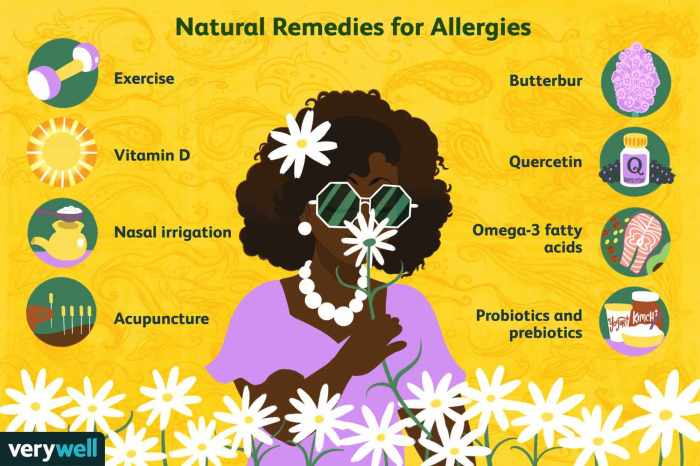
Seasonal allergies can significantly impact daily life, making simple tasks feel challenging. Effective management strategies are crucial for minimizing discomfort and maximizing well-being. This section explores practical techniques for navigating allergy symptoms throughout the seasons and during travel, along with important considerations for severe reactions.Understanding the nuances of seasonal allergy relief is key to developing a personalized approach.
By learning about triggers, symptoms, and effective management strategies, you can better control your allergy experience and maintain a comfortable lifestyle.
Managing Allergy Symptoms During Different Seasons
Seasonal allergies are often tied to specific pollen counts and environmental conditions. Adjusting your daily routine and taking proactive steps can make a substantial difference. Spring, for example, often brings high pollen counts from trees and grasses. Fall frequently sees elevated pollen levels from ragweed, contributing to allergy symptoms. Summer brings the possibility of weed pollen, and early spring brings the potential for mold spores.
- Spring: Limit outdoor activities during peak pollen hours, which are typically midday. Consider wearing a mask when gardening or engaging in outdoor activities. Regularly wash your hair and change clothes after being outdoors to minimize pollen carry-in. Use air conditioning to filter pollen indoors.
- Summer: Use air conditioning to keep pollen out of your home and workplace. Consider installing high-efficiency particulate air (HEPA) filters in your home to remove allergens from the air. Avoid being outdoors during peak pollen hours.
- Fall: Avoid outdoor activities during high pollen counts, which are often in the afternoon. Regularly wash your hair and clothes after spending time outdoors. Use HEPA filters or air purifiers to remove pollen from the air inside your home.
- Winter: While pollen counts are generally low, indoor allergens like dust mites and pet dander can still be present. Regularly clean your home and wash bedding to minimize exposure to these allergens.
Strategies for Managing Allergy Symptoms When Traveling, How to get rid of seasonal allergies
Traveling can present unique challenges for those with seasonal allergies. Understanding how to prepare and adapt your approach can ensure a smooth and comfortable journey.
- Research Destination: Check pollen counts and local allergy information before your trip. This allows you to anticipate potential issues and prepare accordingly. Local weather reports can also offer clues about potential allergen levels.
- Pack Medications: Bring your allergy medication, including any prescribed nasal sprays or antihistamines. Ensure you have a sufficient supply to cover the duration of your trip.
- Inform Accommodations: If you have severe allergies, inform your hotel or accommodation provider of your needs. This might involve requesting a room away from pollen-prone areas or ensuring access to necessary amenities like air purifiers.
- Avoid Triggers: Be mindful of potential triggers like outdoor activities during peak pollen hours or exposure to mold in humid environments.
Seasonal Allergy Relief Techniques Effectiveness Table
| Technique | Effectiveness | Considerations |
|---|---|---|
| Regularly washing hair and clothes after being outdoors | High | Minimizes pollen carry-in |
| Using air conditioning | Moderate | May not fully eliminate pollen |
| Using HEPA filters | High | Reduces indoor allergens |
| Avoiding outdoor activities during peak pollen hours | High | Reduces exposure to allergens |
| Taking prescribed allergy medications | High | Follow doctor’s instructions |
Common Misconceptions About Seasonal Allergies
Some common misconceptions surround seasonal allergies. Understanding these misconceptions can lead to more informed decisions about your health and well-being.
- Seasonal allergies are only a mild inconvenience: While some people experience mild symptoms, severe allergies can significantly impact daily life and lead to serious complications.
- Allergy symptoms are always predictable: Allergy symptoms can vary depending on individual sensitivities and environmental factors. Pollen counts, weather patterns, and other conditions influence severity.
- Over-the-counter medications are sufficient for everyone: For severe cases, prescription medications or allergy shots may be necessary to manage symptoms effectively.
Coping with Severe Allergy Attacks
Severe allergy attacks require immediate medical attention. Understanding the signs and symptoms, and having a plan in place, is crucial.
- Recognize Symptoms: Be aware of the signs of a severe allergic reaction, such as difficulty breathing, swelling of the face or throat, and hives. Anaphylaxis is a severe, life-threatening reaction.
- Carry an Epinephrine Auto-Injector: Individuals with a history of severe allergic reactions should carry an epinephrine auto-injector (e.g., EpiPen) and know how to use it properly.
- Seek Immediate Medical Help: If you experience a severe allergic reaction, call emergency services immediately.
Final Conclusion
Conquering seasonal allergies is a journey, not a sprint. This guide has provided a roadmap to understanding your triggers, minimizing exposure, and finding relief through various approaches. Remember, a personalized strategy tailored to your specific needs is key. By combining preventative measures, medical treatments, natural remedies, and lifestyle adjustments, you can effectively manage your seasonal allergies and enjoy life to the fullest.
